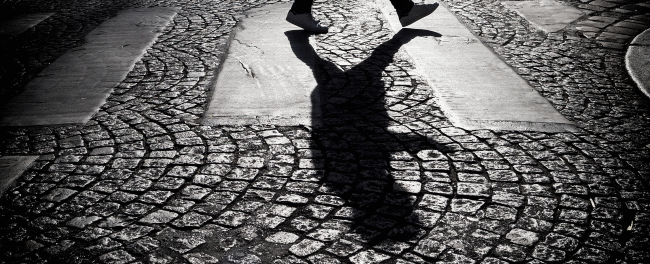Shadows of the Unseen
Sat Jun 23 2018
This is the long-delayed part 4 in my series on show, don’t tell (SDT). Sorry for the wait, but life happens. You know how it is. If you’re only now finding this series, here’s part 1, on converting scenes into summaries, part 2, on presenting facts, not conclusions, and part 3 on trusting your readers.
Today, I want to talk about how showing relates to the distinction between what we can and cannot see in our lives, and just as equally, what readers can and cannot see in our stories.
Showing is about inference
Take a minute to look at the picture at the top of this article and think about what you see.
In the most literal sense, you see a person’s shadow falling on cobblestones. That’s what the picture visibly shows us.
But what else does it convey? Even though all we can see is a tiny piece of ground with somebody’s shadow on it, we can still draw lots of conclusions about the broader scene.
Immediately, we can tell that this is an urban environment. The cobblestones and the crosswalk markings signify that very clearly. And if it’s an urban environment, then probably there are other people around too, cars, streetlights, buildings, cafés and shops, and so forth.
From the length of the shadow we can tell that it’s probably early to mid-morning, or perhaps late afternoon pushing into evening. Could be either, but it’s definitely not mid-day. If I had to pick, I’d say morning because the shiny cobblestones look wet, making me think that perhaps it rained overnight and the ground hasn’t dried off yet. In which case the air is probably cool and moist too, a suggestion which is strengthened by the outline of the person’s clothing, which to me looks like they’re wearing a jacket.
What about the person themselves? Old or young? That’s hard to tell, but I would guess young from the fact that the person seems relatively fit and trim, and from the style of the shoes.
What are they doing? Walking, obviously, but the overall posture of the legs and body suggests that they’re walking purposefully. Going somewhere, not just wandering. And I’d say they’re taking a familiar route to a familiar place, because the shadow’s arms suggest that the person is reading a book or staring at their phone while they walk, which they would only do on a familiar route. Similarly, I imagine that the person’s mood is an ordinary going-about-one’s-day kind of calm.
That’s a lot of information to pull from a shadow, but that’s what we do, isn’t it? That’s what all we do, automatically and instinctively, with everything we experience in the world. All those inferences are what the picture shows us, even though we can’t see it all directly.
Shadows are a metaphor
For "show, don’t tell," shadows are just a metaphor. They’re a useful model for understanding how we can know about--or at least suspect--stuff we can’t see directly. I can’t directly see or feel the temperature in that picture, but I have a suspicion about it that’s rooted in something that is directly visible. I can’t look inside the person’s brain and see their mood, but that doesn’t stop me from making an inference about it.
This is both how human beings approach the world, and how readers approach stories. That should not be surprising, by the way, in so far as stories present the reader with fictional worlds to enjoy.
We can’t see everything. We can’t know everything. But we can figure out an awful lot of stuff from the parts are available to us.
This is how "show, don’t tell" works. Unseen things cast their shadows into the visible world, and thus reveal themselves to us.
What’s most important in our stories?
Just like the real world, our stories also operate on these two levels of seen and unseen. Visible and invisible.
But stop for a moment to ask yourself what are the most important elements of your story? What is your story really about, at its heart? What drives the story forward? What creates drama in the story’s scenes and moments?
I’d bet that the answers to that are almost universally unseen elements.
Hope. Relationships. Power. Wealth. Love. Struggle. Betrayal. Anger. Challenge. Revenge. Forgiveness.
What matters most is unseen
These, and many more I’m sure you can name, are what drive our stories. And none of them live on the level of what is seen. Take a picture of someone experiencing anger and you won’t see the anger itself. Anger isn’t a physical, tangible thing that reflects light or makes sound and thus is observable by our senses.
Everything on that list exists outside the world of the senses. Those things all exist only inside the hearts and minds of our characters, or in the relationships between characters. They exist as what a person feels, or in the difference between how two people feel. Betrayal lives in the disparity between what one character knows and another character believes.
But all these things are invisible. You can’t see them. You can’t touch them or smell them or hear them. That doesn’t make them any less real, it just changes how you need to convey them in your stories.
Show the shadows
Because here’s the key: Just as all of those most-important elements of our stories are unseen elements, every single one of them makes itself known through the shadows it casts into the visible world.
I can’t see the anger itself in a picture of an angry person. But I can sure see the shadow that anger casts on the person’s face. Or in the set of their jaw, or in their clenched fists, or in any number of other visible expressions of their invisible anger.
All the unseen elements cast their shadows in how our characters behave. And, conveniently, behaviors are expressed in the visible world where readers can see them.
If you’re not accustomed yet to writing in a "show" oriented way, you will be tempted to directly describe your story’s unseen elements through labels:
John was angry at Mary’s betrayal.
"Angry" and "betrayal" are labels for an emotion and a particular category of actions. Putting those labels on the page is classic "telling," and is dull as dirt. There’s no life in it, because directly states what the unseen elements are.
Instead, think about how those elements would affect the characters’ behavior--through dialogue, body language, and actions--and write about that instead:
John thrust himself out of his seat, turning and pacing. His fists clenched at his sides. He fixed his gaze out the window, watching all the poor idiots on the street who had no idea how quickly their lives could turn to utter crap.
"John?" Mary’s voice quavered. "Say something. I’m so s--"
"Oh, don’t even say you’re sorry!" He spun to face her. "What good is sorry? Look, just get out." He sighed, his shoulders sagging the tiniest amount. "Please. Just go, ok? I need some time, and then we’ll talk."
Whatever important thing you’re trying to convey, find its shadows and show them.
I promise you, there are always shadows. There have to be. Because if there weren’t--if some unseen thing did not manifest in any way whatsoever in the visible world--then it would have no impact on the world and thus wouldn’t actually matter after all.
Everything that matters has shadows. The specifics will depend on the immediate situation your characters are in, their backstories, their personality, and so forth. But I promise you, the shadows will be there.
Your job as a writer is to find them and write them down.
Let readers find the unseen.
And as soon as readers see the shadows, they will automatically and instinctively start making inferences about invisible stuff. Readers will deal with your story’s world in exactly the same way they deal with the real world.
Think back to part 2 of this series on presenting facts, not conclusions. Every visible thing you show your readers is a fact they can--and will--use to draw conclusions.
A different John in the vignette above, someone with a different personality, would react very differently. Which means that his reaction is just as indicative of his personality as it is of his emotions to learning of Mary’s betrayal. This is the incredible power of showing: just like in the picture at the top of this article, every shadow comes with layers upon layers of meaning readers can access through that automatic, instinctive process of inference.
And that’s the fun of reading, isn’t it? As a reader, our engagement with the story comes from peeling back all those layers to find what’s hidden beneath. It’s in working out what unseen elements are responsible for the shadows we just saw. When you tell, when you name the unseen elements, you rob the reader of the fun part.
Showing makes the unseen real
Readers have an entire lifetime of experience in finding the unseen elements behind the shadows of other people’s behaviors. Consequently, the best way a story can convey the those elements is through their shadows.
Drawing inference from shadows is how we experience other people’s invisible, hidden mental lives. Equally so whether the other person is our spouse, a friend, or a character in a book. It’s all the same process, and readers are really good at it. Leverage those skills. Put them to work for you.
Just like the real world, your story’s world exists on the levels of the seen and the unseen. These two levels are connected by shadows. And thus, presenting the meaningful world of the unseen through its shadows is how you make that unseen world real for your reader.
Conclusion
I’d like it if I could take sole credit for this metaphor, because it’s the best one I’ve yet found for explaining the core essence of "show, don’t tell". But I can’t. The metaphor comes from Dr. Martin Luther King, Jr., who said this:
Everything that we see is a shadow cast by that which we do not see.
It’s a beautiful quote. Commit it to memory, for it will serve you well. Because while King was talking about racism and its long shadows cast upon on our society, the idea applies to writing just the same.
Next up, the final installment in this series on how showing creates emotions and beliefs.

 @sonjablack.bsky.social
@sonjablack.bsky.social